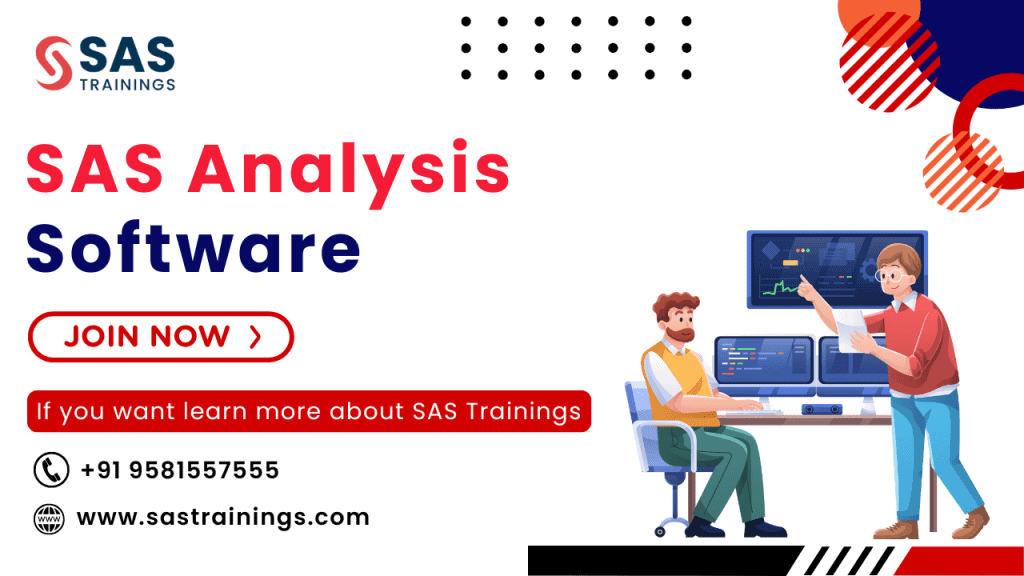SAS Software FAQ
1. What is SAS Software?
- SAS (Statistical Analysis System) is a powerful software suite used for advanced analytics, data management, statistical analysis, predictive modeling, and business intelligence. It is widely used in industries such as healthcare, finance, and manufacturing for data-driven decision-making.
2. What are the main features of SAS Software?
- Data Management: Import, clean, and manipulate data from various sources.
- Statistical Analysis: Perform a wide range of statistical analyses, including regression, ANOVA, and survival analysis.
- Reporting & Visualization: Create dynamic reports, dashboards, and visualizations.
- Advanced Analytics: Implement machine learning, predictive modeling, and data mining techniques.
- Industry Solutions: Tailored tools for industries like healthcare, finance, and manufacturing.
3. What are the different modules in SAS Software?
- Base SAS: Core functionalities for data management and analysis.
- SAS/STAT: Statistical analysis tools.
- SAS/GRAPH: For creating graphs and visualizations.
- SAS/SQL: SQL-based data manipulation and management.
- SAS/ACCESS: Interfaces for connecting with databases like SQL Server, Oracle, and Hadoop.
- SAS Enterprise Guide: A GUI for non-programmers to perform analysis.
- SAS Viya: A cloud-based platform for advanced analytics, machine learning, and big data integration.
4. How does SAS differ from other analytics software?
- Powerful Analytics: SAS has a long history of advanced statistical and analytical capabilities, making it a top choice for complex analytics and large datasets.
- Scalability: SAS can handle massive datasets and is suitable for both small organizations and large enterprises.
- Industry-Specific Solutions: SAS offers tailored tools for industries such as pharmaceuticals, finance, and healthcare, making it a preferred choice for regulatory reporting and compliance.
- Security and Compliance: SAS is known for its robust security features, particularly in industries with strict regulations, like healthcare and finance.
5. Is SAS easy to learn?
- SAS has a steep learning curve, especially for those without programming experience. However, it provides comprehensive documentation, online courses, and a large user community to assist learners. SAS Enterprise Guide, which offers a point-and-click interface, is more user-friendly for beginners.
6. What is the difference between SAS and R?
- SAS: Commercial software with strong support, stability, and industry-specific solutions. It is preferred in regulated environments like healthcare and finance.
- R: An open-source software with a broad community and extensive statistical packages. While R offers flexibility and powerful statistical tools, it requires more programming expertise and doesn’t have the same level of enterprise support as SAS.
7. Can SAS be used for machine learning?
- Yes, SAS has robust tools for machine learning and artificial intelligence. SAS Viya, in particular, offers advanced capabilities for building and deploying machine learning models, including automated machine learning (AutoML) features.
8. What industries use SAS software?
- Healthcare: Clinical trials, regulatory reporting, patient data analysis.
- Finance: Risk management, fraud detection, credit scoring, regulatory compliance.
- Manufacturing: Supply chain optimization, production analytics, quality control.
- Government: Public policy analysis, data governance, statistics.
- Retail: Customer insights, demand forecasting, inventory management.
9. What is SAS Viya?
- SAS Viya is a cloud-based analytics platform that supports advanced analytics, machine learning, AI, and big data processing. It integrates with popular cloud services like AWS, Google Cloud, and Microsoft Azure, providing scalability and collaboration features. It’s designed to be more user-friendly than traditional SAS software, with an emphasis on AI and machine learning.
10. What are the system requirements for SAS software?
- Base SAS: Requires a Windows, Linux, or UNIX operating system. It needs a minimum of 8GB of RAM, with more recommended for larger datasets.
- SAS Viya: Requires a cloud-based infrastructure, which can scale depending on the workload.
11. How do you get started with SAS software?
- Download: You can start with SAS University Edition, which is free for non-commercial use and includes a limited set of features for learning.
- Training: SAS offers online training, certifications, and a vast collection of resources and forums to help you get started.
- SAS Community: Join the SAS community for tips, troubleshooting, and collaboration with other users.
12. Can SAS be used for big data analysis?
- Yes, SAS has strong capabilities for handling and analyzing big data, particularly with SAS Viya and integration with big data platforms like Hadoop and Spark.
13. What is SAS programming?
- SAS programming involves writing code in the SAS programming language to manipulate and analyze data. It allows users to create datasets, perform statistical analysis, generate reports, and implement predictive models.
14. How does SAS support data visualization?
- SAS includes tools like SAS/GRAPH and SAS Visual Analytics for creating interactive graphs, charts, and dashboards. It also allows for integration with tools like Tableau and Power BI for advanced visualizations.
15. Is SAS a good investment for companies?
- Yes, SAS is widely regarded as a reliable and scalable solution for organizations that require high-level data analytics, particularly in industries like healthcare, finance, and government. Its support, security, and compliance features make it a good investment for companies in regulated environments.
